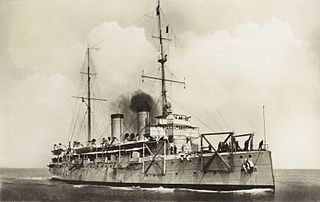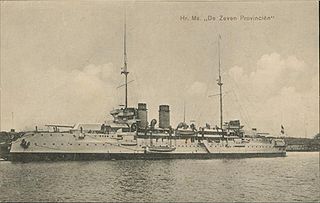
HNLMS Gelderland was a Holland-class protected cruiser of the Royal Netherlands Navy. During its career in the Dutch Navy it was most notable for being the ship Queen Wilhelmina sent to Portuguese East Africa to transport Paul Kruger to Europe during the Second Boer War. The ship was taken over by the Germans during World War II, rebuilt as an anti-aircraft cruiser and renamed Niobe. Commissioned into the German navy on 1 March 1944, she was sunk in Kotka harbour in Finland on 16 July 1944.

HNLMS Van Ghent was an Admiralen-class destroyer built for the Royal Netherlands Navy in the 1920s. The destroyer served in the Netherlands East Indies but was wrecked after running aground in 1942.

HNLMS De Zeven Provinciën was a Royal Netherlands Navy coastal defence ship in service from 1910 until 1942. It was a small cruiser-sized warship that sacrificed speed and range for armor and armament. She was armed with two 283 mm, four 150 mm, ten 75 mm, four 37 mm guns, in addition to a few 75 mm mortars. She was 101.5 metres (333 ft) long, had a beam of 17.1 metres (56 ft) and a draft of 6.15 metres (20.2 ft), and displaced 6,530 tons. She had a crew of 448 and was able to reach 16 knots.

HNLMS Zuiderkruis (A832) was a replenishment oiler operated by the Royal Netherlands Navy. Zuiderkruis entered service in 1975 and was decommissioned on 10 February 2012. Her design was based on the earlier replenishment ship Poolster. The ship has been stripped for parts and left Den Helder for scrapping in Turkey on 21 February 2014.

HNLMS Witte de With was an Admiralen-class destroyer, named after the 17th-century Dutch admiral of the same name. She served during World War II.

HNLMS Marten Harpertszoon Tromp was a unique coastal defence ship of the Royal Netherlands Navy built by the Rijkswerf in Amsterdam.

HNLMS Koningin Wilhelmina der Nederlanden was a unique protected cruiser of the Royal Netherlands Navy built by the Rijkswerf in Amsterdam.

HNLMS Evertsen was a Admiralen-class destroyer of the Royal Netherlands Navy. She was destroyed by ships of the Imperial Japanese Navy on 1 March 1942, during the Battle of Sunda Strait.

HNLMS Piet Hein was an Admiralen-class destroyer of the Royal Netherlands Navy, named after 17th century Dutch Admiral Piet Pieterszoon Hein.

HNLMS Koningin Regentes was a Koningin Regentes-class coastal defence ship (pantserschip) of the Royal Netherlands Navy. The ship was built at the Rijkswerf in Amsterdam at the start of the twentieth century. After the eruption of the Mount Pelée volcano on the French island of Martinique the ship provided assistance to the casualties, and then later participated in an expedition to the island of Bali in 1906. She made several journeys to show the Dutch flag and was finally decommissioned in 1920.

HNLMS De Ruyter was a Koningin Regentes-class coastal defence ship (pantserschip) of the Royal Netherlands Navy. The ship was built by the Maatschappij voor Scheeps- en Werktuigbouw Fijenoord in Rotterdam just after the turn of the 20th century. The ship participated in two colonial expeditions in the Dutch East Indies. She made several journeys to show the flag and was finally decommissioned in 1923.

HNLMS Hertog Hendrik was a Koningin Regentes-class coastal defence ship (pantserschip) of the Royal Netherlands Navy. The ship was built at the Rijkswerf in Amsterdam at the start of the twentieth century. She was the first ship in the Dutch navy to be equipped with wireless communication. The ship took part in two expeditions to South Celebes and during the Spanish Civil War she performed convoy duties. During World War II she was captured by the invading German forces and converted into an anti-aircraft battery. After the war the ship was recovered and given back to the Netherlands, to be converted into an accommodation ship.

HNLMS Holland was a Holland-class protected cruiser of the Royal Netherlands Navy.

HNLMS Friesland was a Holland-class protected cruiser of the Royal Netherlands Navy.

HNLMS Utrecht was a Holland-class protected cruiser of the Royal Netherlands Navy.

HNLMS Noordbrabant was a Holland-class protected cruiser of the Royal Netherlands Navy.

HNLMS Sumatra was a Java-class cruiser of the Royal Netherlands Navy. She was launched during World War I and saw action during World War II. She was scuttled off the coast of Normandy on 9 June 1944 at Ouistreham as part of a "gooseberry" pier to protect an artificial Allied Mulberry Harbour built as part of Operation Overlord.

HNLMS Java was a Java-class cruiser of the Royal Netherlands Navy. She was sunk during the Battle of the Java Sea on 27 February 1942.

HNLMS Van Galen was a Admiralen-class destroyer of the Royal Netherlands Navy, named after the 17th century Dutch Commodore Johan van Galen. She served during World War II. The opening chapter of E.H.Larive's autobiography 'The Man Who Came In From Colditz' describes in detail the craft's demise.

HNLMS Abraham van der Hulst was a ship of the Karel Doorman-class of multi-purpose frigates of the Royal Netherlands Navy where it used the radio call sign was "PAMF". Built by the shipyard Koninklijke Schelde Groep in Vlissingen. The ship is named after the Dutch Admiral Abraham van der Hulst. She was sold to the Chilean Navy where the ship was renamed Almirante Blanco Encalada.





















